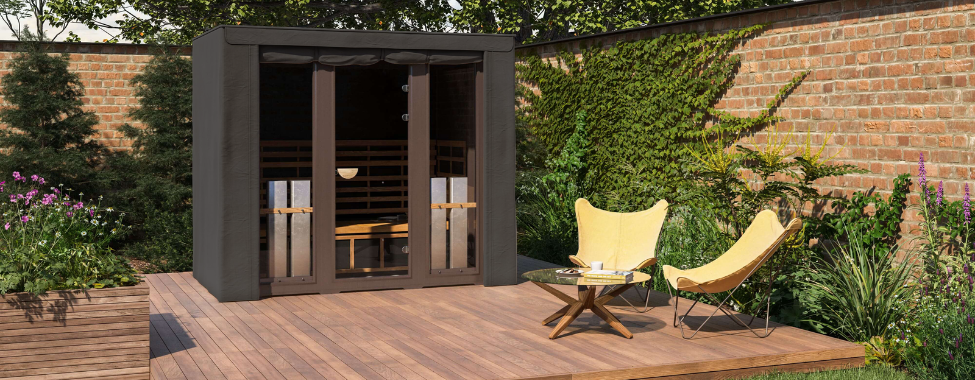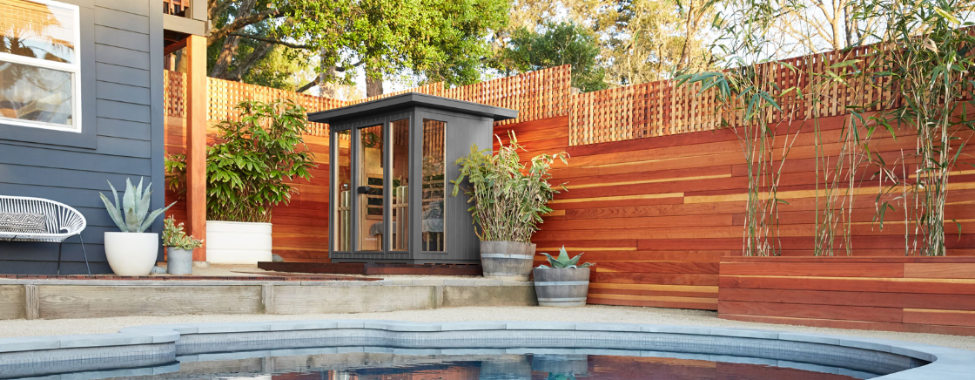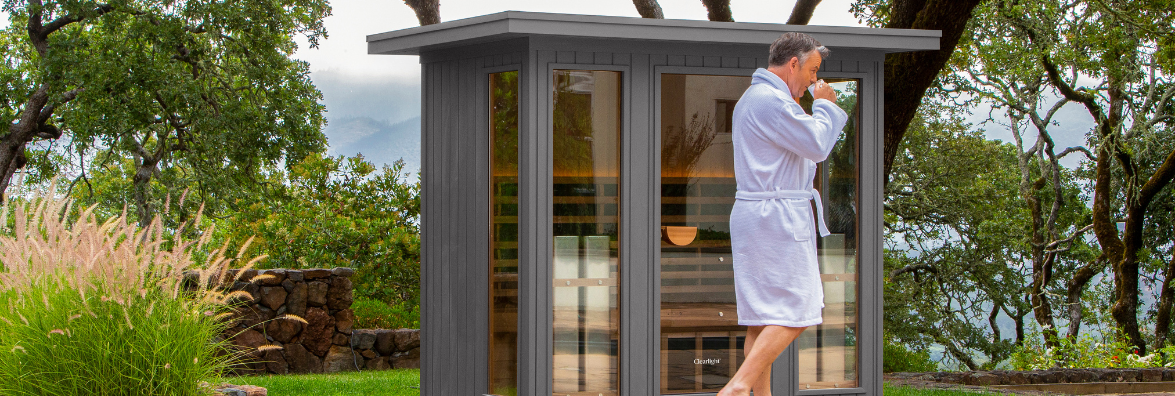- 27 Jun, 2025
- /
- Clearlight Infrared Saunas
- /
- No Comments
What to Consider When Choosing an Outdoor Infrared Sauna
Adding an outdoor infrared sauna to your home or business is a powerful way to elevate wellness, support recovery, and create a relaxing retreat right in your backyard. But to make the most of your investment, it’s essential to choose the right unit for your environment and your needs. From sauna size and wood type to weather durability and placement, here are the most important factors to consider before purchasing an outdoor infrared sauna.
Sauna Size and Capacity: Who Will Be Using It?
The first thing to think about is who will be using your sauna and how often. Are you looking for a private wellness escape for one or two people, or do you need something larger to accommodate family or clients?
Outdoor infrared saunas are typically available in smaller sizes meant for 1-2 people, or larger sizes meant for 4-5 people. If you want a more spacious interior for stretching or hot yoga, a 5-person sauna is a great size for being able to be active. For businesses, larger models are often better suited to meet the needs of multiple users throughout the day.
Make sure to account for door clearance and any additional space needed for accessories, ventilation, or external covers. The unit should be easy to access, and the doors should open fully without obstruction.
Pro Tip: Measure your available outdoor space before choosing a size. You’ll want enough clearance on all sides to accommodate maintenance and ensure proper airflow.
Materials and Construction: What is It Made Of?
Outdoor saunas need to withstand year-round exposure to the elements, so the materials used in construction matter more than they would for an indoor model.
High-quality infrared saunas often use a combination of engineered exterior wood and dense interior hardwoods like mahogany. Engineered wood provides a weather-resistant outer shell that holds up against UV rays, rain, and snow, while hardwood interiors are naturally resistant to mold and moisture damage.
Well-designed saunas also use double-pane glass and thick, insulated double wall panels with a tongue-and-groove construction. This not only improves energy efficiency, but also helps retain heat for longer, even in colder climates. Avoid saunas made with untreated or soft woods, which may warp or rot over time. If you live in a particularly humid or snowy area, material durability should be a top priority.
Placement and Location: Where Should You Put It?
Placing your sauna in the right outdoor spot will make a big difference in how easy it is to use and maintain. Look for a location that is flat, level, and easily accessible from the home or main building.
Many people install outdoor saunas near a pool, hot tub, cold plunge, or outdoor shower to enhance the experience and make transitions more convenient. If you’re in a cold climate, consider a location close to an entryway to reduce time spent in freezing temps. In hot climates, you may want to position the sauna in partial shade to minimize exterior heat exposure and sun damage.
It’s also important to think about overhead coverage. Even if the sauna is built with weather-resistant materials, providing additional shelter such as a canopy or overhang can extend its lifespan and reduce wear.
Pro Tip: Make sure there’s enough space around the unit for any required electrical connections and proper air circulation. A dedicated base of pavers or a concrete slab is often recommended for stability.

Weather Protection: How Will It Hold Up Outside?
Unlike indoor units, outdoor infrared saunas are subject to harsh environmental conditions, so weatherproofing features are essential. If you don’t have a covered area in your outdoor space, look for saunas that include or offer optional outdoor covers. These help shield the unit from rain, snow, wind, and UV rays, reducing the risk of long-term damage. A good cover should fit well and be made from waterproof, UV-resistant materials.
Additionally, insulation plays a big role in heat retention and energy efficiency. High-quality saunas use thick wall insulation and tightly sealed doors to keep heat in and cold air out. Double-paned glass on the windows further enhances insulation and provides safety benefits.
If you live in a coastal or high-humidity area, check for mold-resistant materials and rust-proof hardware. Regular maintenance and a well-fitted cover will go a long way in protecting your investment.
Technology and Features: What Enhances the Experience?
Infrared saunas come with a variety of wellness-enhancing features that can make your sessions more enjoyable and effective. These include:
- Full-spectrum infrared heaters that provide near-, mid-, and far-infrared wavelengths for deeper tissue penetration.
- Chromotherapy lighting (color therapy) to support mood regulation and relaxation.
- Bluetooth audio systems so users can enjoy music, podcasts, or meditations.
- Digital control panels to easily adjust temperature and session duration.
Some models even include ergonomic backrests, ceiling vents, or medical-grade red light therapy. While these features aren’t required, they can make the difference between a good experience and a great one, especially if you use your sauna frequently. You can also add complementary features such as red light therapy, aromatherapy, or halotherapy to create an outdoor oasis.
Electrical Requirements: Are You Ready to Power It?
Outdoor infrared saunas are typically powered by a 240-volt outlet, which is different from the standard 120-volt household plug. Before installation, make sure your space has the correct electrical infrastructure in place or that you are prepared to hire an electrician.
A dedicated circuit is often required to avoid tripping breakers or overloading your electrical panel. Electrical access should also be weather-safe, meaning outlets and cords must be protected from rain or snow.
Be sure to check your local building codes and HOA guidelines (if applicable) to ensure compliance. Permits may be required in some regions for new 240v installations. Planning ahead with a licensed contractor or electrician can help avoid costly delays or unsafe installations.

FAQ: Outdoor Infrared Sauna Considerations
Can I use my infrared sauna year-round?
Yes, as long as your sauna is properly weatherproofed with insulated walls and a quality cover, it can be used in all seasons.
What surface should my sauna sit on?
The best surfaces are flat, stable, and weather-resistant, such as concrete, stone pavers, or a treated wood deck. Avoid placing directly on grass or soil.
Does my sauna need to be covered?
A weatherproof cover is highly recommended to protect your sauna from the elements and extend its lifespan.
How long does it take an outdoor infrared sauna to heat up?
Most infrared saunas take 10–20 minutes to reach optimal temperature, depending on the ambient weather conditions and unit size. But remember that infrared is different in that as long as the heaters are running, your body is absorbing its benefits, even at lower temperatures.
Do I need a permit to install an outdoor sauna?
That depends on local building codes. Check with your city or HOA to determine if any permits or inspections are required for electrical work or outdoor structures.
Creating Your Outdoor Oasis with a Sauna
Choosing the right outdoor infrared sauna is about more than aesthetics. From selecting the right size and materials to understanding placement and power needs, each factor plays a role in the safety, comfort, and durability of your sauna. By considering your climate, usage, and preferences, you can create a wellness space that brings lasting value to your home or business.
 Canada
Canada Australia
Australia New Zealand
New Zealand Germany
Germany UK
UK EU
EU Ireland
Ireland Malaysia
Malaysia China
China Japan
Japan



